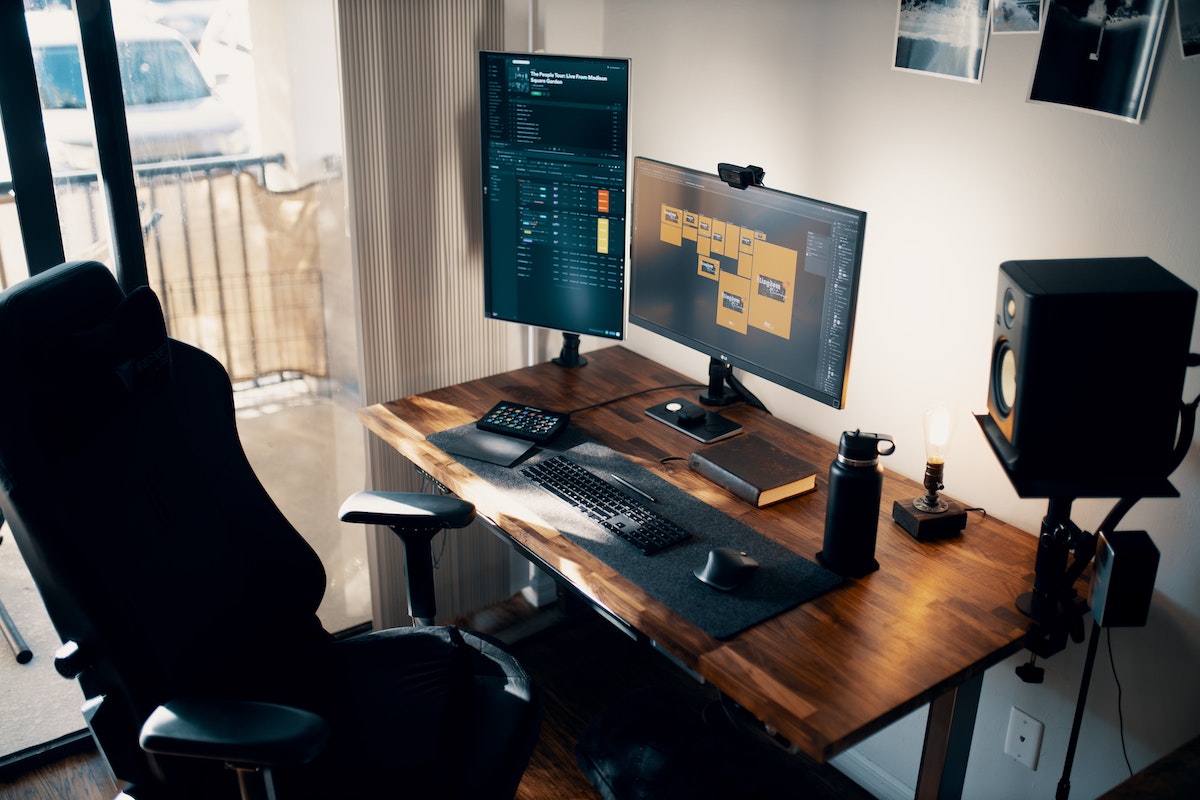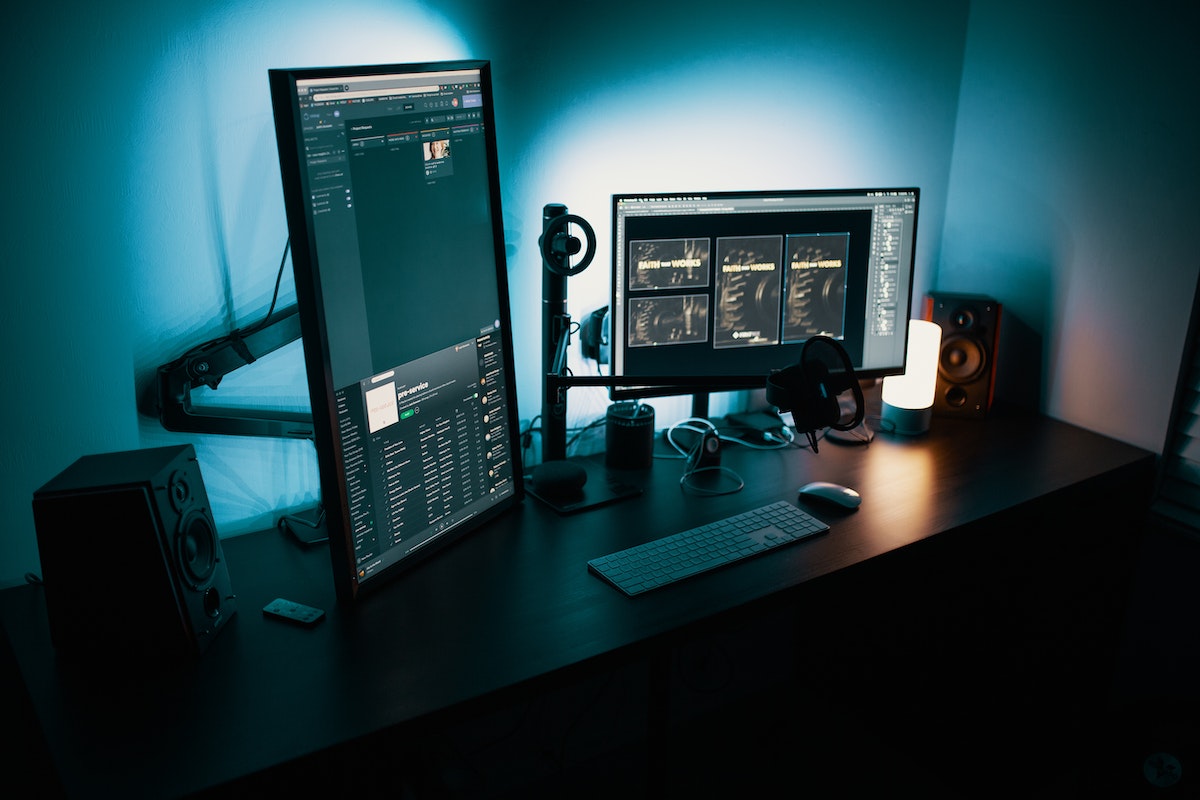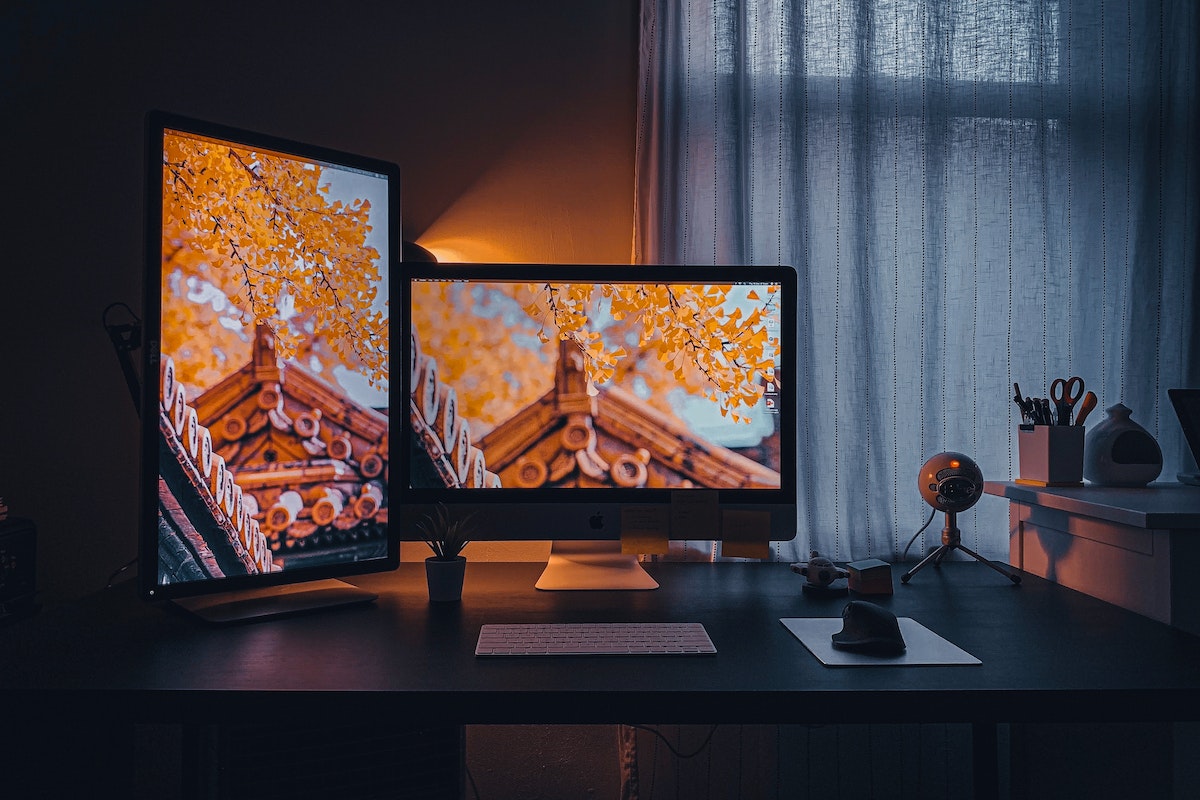In recent years, vertical monitor setups have surged in popularity, and it’s no surprise why. This innovative approach to monitor orientation offers many benefits that can significantly enhance productivity and overall user experience. From coders and designers seeking expanded vertical screen real estate to professionals wanting to optimize document handling and multitasking, vertical monitors have become a game-changer in the modern workspace.
This article will delve into the growing trend of vertical monitor setups and their potential to revolutionize work. With a few simple steps, you can maximize your workspace efficiency and take your productivity to the next level.
Different Ways To Set Up Vertical Monitor
When it comes to setting up a vertical monitor, there are several options available. The type of setup you decide to go with depends on the number and size of monitors you have and your individual workspace requirements.
Portrait Mode vs. Landscape Mode

When it comes to mounting a vertical monitor, one of the critical decisions you’ll face is choosing between portrait mode and landscape mode. These two orientations profoundly impact your workflow, visual experience, and productivity.
Portrait mode refers to a monitor’s vertical orientation, where the screen’s height is greater than its width. This orientation replicates the conventional format of documents and books, making it perfect for reading, coding, or working with extensive spreadsheets. Mounting a vertical monitor in portrait mode allows you to view more content without constant scrolling, making it a valuable choice for tasks requiring a continuous vertical workspace.
On the other hand, landscape mode is the horizontal orientation most commonly associated with monitors. In this mode, the screen’s width is more significant than its height, resembling the natural field of vision. Landscape mode is excellent for tasks that involve graphics, video editing, gaming, and web browsing, as it provides a broader and more immersive view.
Here’s a comparison table highlighting the advantages and disadvantages of each orientation:
| Aspect | Portrait Mode | Landscape Mode |
| Advantages | – Ideal for reading | – Suited for multimedia |
| – Better for coding | – Great for gaming | |
| – Efficient for long lists | – Wider view for graphics | |
| Disadvantages | – Limited width for visuals | – More scrolling for text |
| – Narrower view for videos | – Less code visible at once | |
| – Less suitable for gaming | – Smaller spreadsheet cells |
Single Vertical Monitor Setup
Incorporating a single vertical monitor into your workspace can significantly improve your efficiency, reduce eye and neck strain, and enhance your overall computing experience, especially for tasks that involve vertical content like code and documents. Customizing your setup and optimizing display settings and ergonomics will ensure you reap the full benefits of this configuration.
- Hardware Setup:
- Monitor Choice: Select a monitor with an adjustable stand that can be rotated to portrait (vertical) mode. Ensure it has a resolution suitable for your needs.
- Physical Placement: Position the monitor so that it is at eye level when you are seated comfortably. The screen should be directly in front of you to minimize neck strain.
- Cable Management: Organize and secure cables to avoid clutter and potential interference with your workspace.
- Display Settings:
- Orientation: Adjust the monitor’s orientation to portrait mode through your computer’s display settings. This typically involves right-clicking on the desktop, selecting “Display Settings,” and choosing “Portrait” under the “Orientation” dropdown menu.
- Resolution: Set the screen resolution to match the monitor’s native resolution for the best image quality.
- Scaling: Depending on your monitor’s size and resolution, you may need to adjust text and app scaling to ensure readability.
- Ergonomics:
- Monitor Position: Ensure the top of the monitor is at or slightly below eye level to reduce neck strain. Use a monitor stand or mount if necessary.
- Keyboard and Mouse: Position your keyboard and mouse at a comfortable height and distance from the monitor to maintain proper wrist and hand alignment. Consider keyboards equipped with the best linear switches for a smoother typing experience and reduced strain on your fingers and wrists.
- Chair and Desk: Adjust your chair and desk height to maintain a neutral wrist, arm, and back posture.
Benefits of a Single Vertical Monitor

- Coding: Vertical monitors are especially advantageous for coding tasks. They allow you to view more lines of code at once, reducing the need for constant scrolling and improving workflow efficiency.
- Document Editing: When editing long documents, such as reports or manuscripts, a vertical monitor offers a natural layout that resembles reading a physical page. This minimizes the need for horizontal scrolling and enhances your editing experience.
- Research and Reading: Reading articles, research papers, or web pages becomes more comfortable as you can see more content vertically, reducing the need to scroll frequently.
- Multitasking: A vertical monitor is excellent for side-by-side multitasking. You can have a document open on one side while referencing another document or a web page on the other, boosting productivity.
Dual Vertical Monitor Setup
A dual vertical monitor setup offers an exceptional boost in productivity and versatility, making it an excellent choice for various professional tasks, from stock trading to graphic design. This configuration provides ample benefits, including the following:
- Expanded Vertical Workspace: The most significant advantage of dual vertical monitors is the extended vertical screen space. This is particularly valuable for tasks that require viewing or editing long documents, coding, or working with timelines in graphic design or video editing.
- Multitasking: With two vertical monitors side by side, you can multitask effectively. Keep reference documents, chat windows, or secondary applications open on one screen while focusing on your primary task on the other.
- Specialized Workflows: Professions like stock trading benefit immensely from a dual vertical setup, allowing traders to monitor multiple stocks and financial data simultaneously. Graphic designers can view detailed project timelines and reference materials side by side.
Configuration and Setup
- Monitors: Choose two monitors that support vertical orientation and have matching resolutions and sizes for a uniform display. Mount them on adjustable dual monitor stands or wall mounts.
- Physical Placement: Position the monitors side by side with minimal bezel separation. Ensure the top of each monitor aligns with or slightly below your eye level.
- Cable Management: Keep cables organized to prevent clutter and tangling. Using cable clips or channels can help maintain a neat workspace.
- Display Settings: Adjust your computer’s display settings to enable dual monitors. Set each monitor to portrait mode in the display settings to ensure a vertical orientation.
- Resolution and Scaling: Ensure both monitors have the same resolution and text scaling settings for a consistent visual experience.
Vertical Monitor in a Multi-Monitor Setup

You can create a highly efficient and ergonomic workspace by integrating a vertical monitor into your multi-monitor setup and optimizing its use for tasks that benefit from vertical screen space. Here’s a guide on seamlessly incorporating a vertical monitor and making the most of its potential in conjunction with horizontal monitors.
- Selecting the Vertical Monitor: Choose a vertical monitor that complements your existing horizontal monitors in terms of size and resolution. Ensure it supports portrait orientation.
- Physical Placement: Position the vertical monitor alongside your horizontal monitors. The top of the vertical monitor should align with or be slightly below your eye level. Use an adjustable monitor stand or mounting arm to achieve the desired placement.
- Cable Management: Organize and secure cables to maintain a clutter-free workspace and prevent tangling.
- Display Settings: Configure the vertical monitor in your computer’s display settings. Set it to portrait mode, ensuring that the screen orientation matches the physical placement.
The advantages of integrating a vertical monitor into your multi-monitor setup are considerable. Not only can you leverage the extra screen space for multitasking, but it also provides an ergonomic solution that reduces neck strain and improves workflow efficiency. Below are some of the top benefits of this configuration:
- Specialized Workflows: A vertical monitor complements horizontal ones by offering a dedicated space for specific tasks. For example, when coding, you can have your code editor on the vertical monitor while keeping documentation or reference materials open on horizontal monitors.
- Reduced Scrolling: Viewing and editing long documents or coding scripts is more efficient on a vertical monitor as it minimizes the need for constant scrolling, enhancing your workflow.
- Multitasking: With a combination of vertical and horizontal monitors, you can multitask effectively. Keep communication apps, reference materials, or emails open on vertical screens while concentrating on your primary work on horizontal screens.
You can further optimize your workspace by customizing ergonomics and display settings. Adjust the monitor height, keyboard and mouse placement, and chair height to ensure a neutral posture and comfortable viewing experience.
Vertical Monitor for Gaming and Entertainment
Using a vertical monitor for gaming can provide a unique and immersive experience, particularly for certain game genres. With the right setup and adjustments, you can elevate your gaming and entertainment on a vertical monitor to a whole new level of enjoyment.
- Monitor Selection: When looking for the best vertical monitor devices for gaming, consider factors like refresh rate, response time, and resolution. Gaming-oriented vertical monitors with fast refresh rates are ideal for a smoother gaming experience.
- Game Configuration: Not all games natively support vertical monitor setups, but many do. Navigate to the in-game settings or graphics options to configure games to work with a vertical monitor. Look for the aspect ratio or resolution settings and choose one that suits your vertical monitor’s resolution. Typically, you’ll want to select a 9:16 or 3:4 aspect ratio.
- Immersive Experience: Gaming on a vertical monitor can provide a unique level of immersion, especially for games that benefit from a taller field of view. Racing games, flight simulators, and first-person shooters can feel more engaging as you have a wider vertical view of the game world.
- Multitasking: Vertical monitors also offer an advantage for multitasking during gameplay. You can open a guide, chat, or streaming software on the vertical monitor while playing the game on your primary horizontal monitor.
However, it’s essential to consider game compatibility, aspect ratios, and potential limitations. The following limitations can reduce your gaming experience on a vertical monitor:
- Compatibility: Not all games support vertical resolutions, and some may require additional tweaks or third-party software to work optimally.
- Aspect Ratio: While a vertical monitor can enhance immersion for certain games, it might not be suitable for titles designed primarily for widescreen displays. You may experience stretching or issues with user interfaces.
- GPU Demands: Running games at higher resolutions or across multiple monitors can be demanding on your GPU. Ensure your graphics card can handle the increased workload for a smooth gaming experience.
- Neck Strain: Extended gaming sessions on a vertical monitor may strain your neck more compared to a horizontal display, as you might need to look up and down frequently.
Conclusion
Vertical monitor setups offer versatility that transcends various tasks, from coding and document editing to gaming and entertainment. These configurations can optimize productivity, streamline workflows, and enhance immersion, catering to various individual needs. As vertical monitors continue to gain popularity in professional and creative fields, be sure to explore and experiment with these setups to unlock new levels of efficiency and comfort in their work and play.



